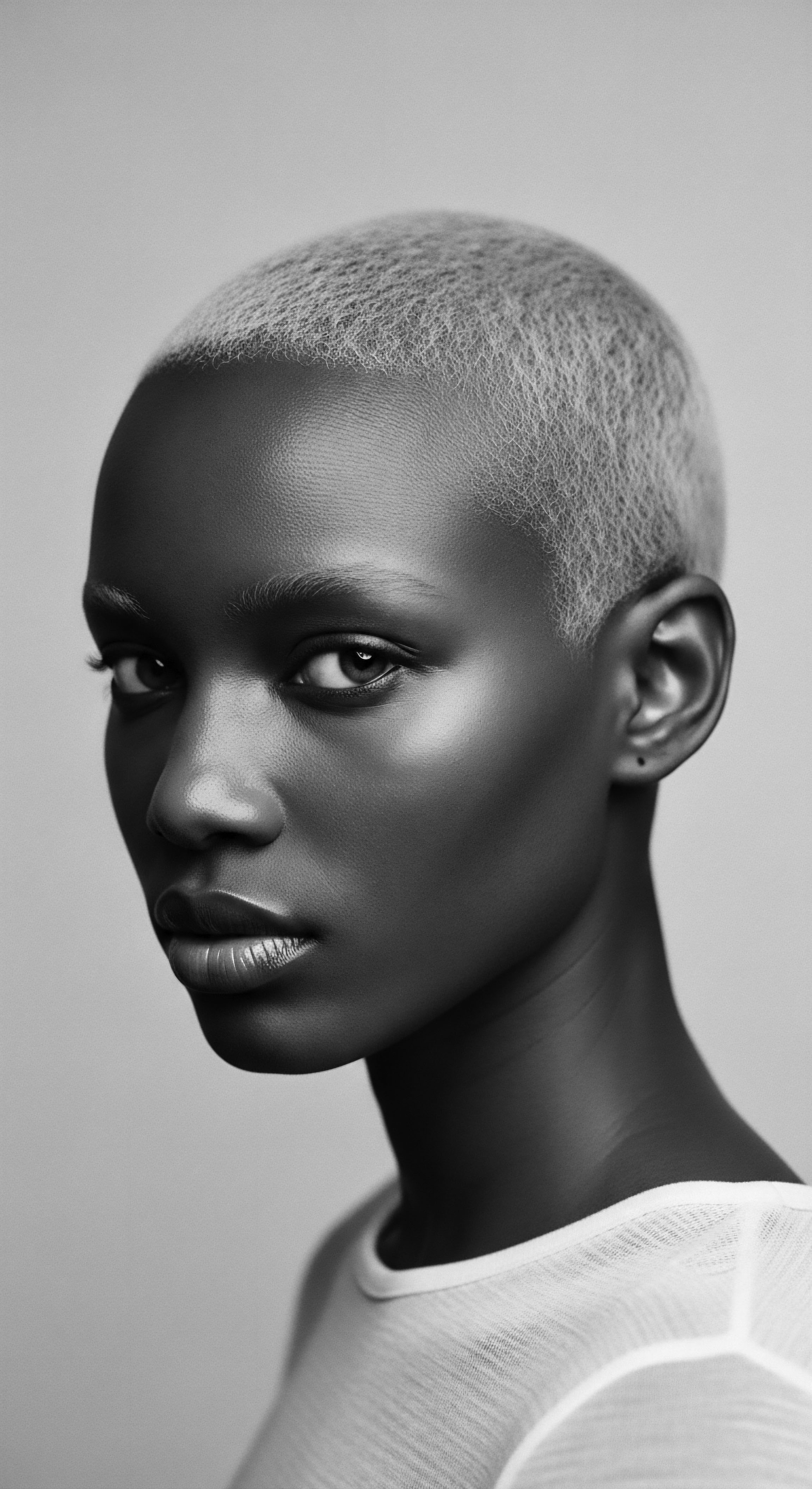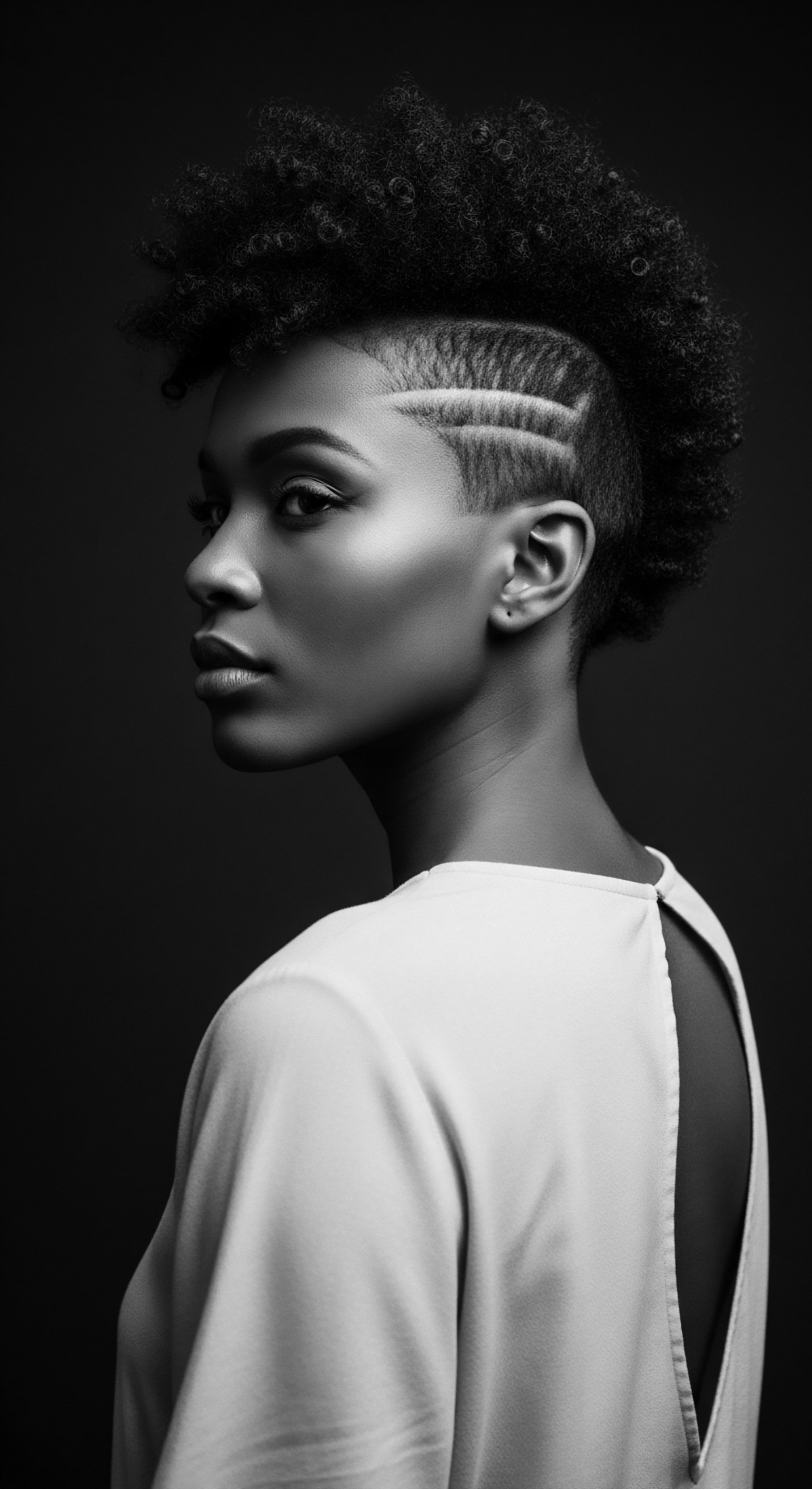
Roots
There are whispers that stretch across epochs, carried on the very wind that shapes our coils and curls. These are the ancestral murmurs, holding secrets to enduring beauty and strength, often found in nature’s quiet bounty. Within this ancient chorus, the unassuming fenugreek seed speaks volumes, its story intimately intertwined with the legacy of textured hair. Our exploration begins not in modern laboratories, but in the deep well of inherited wisdom, reaching for the echoes of practices that shaped generations long before us, shaping our very understanding of hair’s fundamental nature and its intrinsic connection to heritage.

Hair’s Elemental Being Ancestral Views
To truly grasp fenugreek’s place, we must first consider hair itself, not merely as a biological structure, but as a living archive of identity and resilience for those with coils, kinks, and waves. For countless generations across African lands and the vast diaspora, hair has served as far more than adornment; it acted as a symbol of status, spiritual connection, and tribal affiliation. Its health, its vibrancy, its very existence, often mirrored the health of the community and the spirit of the individual.
Ancient perspectives on hair health were often holistic, viewing the body, mind, and spirit as an indivisible whole. A healthy scalp and robust strands reflected internal balance, and remedies were sought from the earth’s offerings.
The understanding of hair’s anatomy, though not articulated in the scientific terms we employ today, was profoundly experiential. Practitioners observed how certain plant preparations softened, strengthened, or encouraged growth. The mucilaginous quality of plants like fenugreek, for instance, was recognized for its ability to detangle and impart a supple feel to the hair, even if the precise polysaccharide structures were unknown. This practical knowledge, passed through oral traditions and hands-on teaching, formed a sophisticated lexicon of care rooted in direct observation and ancestral lore.

Textured Hair’s Historical Language
The language used to describe textured hair in its varied forms is as rich and diverse as the hair itself. Before modern classification systems, communities developed their own descriptive terms, reflecting observations of coil patterns, density, and natural luster. These terms were often embedded within cultural narratives, speaking to the hair’s appearance, its behavior, and its role in communal life.
The emphasis was on characteristics that spoke to its health and how it could be styled for specific cultural expressions. The very concept of “protective styling,” though perhaps not explicitly named as such, was a deep-seated practice, a communal knowledge of how to safeguard the hair for longevity and beauty.
Consider the myriad ways hair was cared for in ancestral communities. Oils, clays, and herbal infusions were not merely cosmetic applications; they were vital rituals that preserved hair structure, particularly in harsh climates, and allowed for the creation of intricate styles that could be maintained for extended periods. This protective instinct, this profound understanding of preservation, forms a direct lineage to our modern practices. The very idea that a plant like fenugreek could contribute to such preservation, nourishing the scalp and coating the strands, speaks to a continuity of wisdom that spans millennia.
Fenugreek’s legacy is rooted in ancestral appreciation for its capacity to nurture hair, reflecting an ancient understanding of holistic wellness for textured strands.

Ancient Echoes of Fenugreek’s Place
Fenugreek, known scientifically as Trigonella foenum-graecum, finds its roots in ancient civilizations across the Mediterranean, Middle East, and South Asia. Its presence in various historical hair care traditions is well-documented. For instance, in ancient Egypt, fenugreek was not just a culinary spice; it held a place in cosmetic and medicinal preparations.
Historical texts, such as a papyrus dating back to approximately 1150 BC, indicate the use of various botanical remedies, including fenugreek seeds, for promoting hair growth and addressing scalp conditions. This practice was part of a wider array of hair and scalp treatments, which included the application of fragrant oils like fir oil, almond oil, rosemary oil, and castor oil, all believed to stimulate hair growth (WebMD, 2025; Botanical Voyage, 2024).
This historical use in Egypt, a civilization deeply connected to African heritage and the diaspora, provides a compelling example of how ancestral knowledge of plant properties directly informed hair care. The meticulous attention given to hair in ancient Egyptian culture, from elaborate wigs crafted from human hair and plant fibers to specific remedies for hair loss, underscores a profound respect for hair health and aesthetics. Fenugreek’s inclusion in these early formulations suggests an observed efficacy that transcended mere anecdote, becoming codified knowledge. It represents an early, intuitive understanding of ingredients that could bolster hair and prepare it for complex, long-lasting styles.
The journey of fenugreek across continents meant its integration into diverse hair care practices. In Ayurvedic tradition, a system of medicine with deep historical roots in India, fenugreek, or ‘methi,’ has been a celebrated ingredient for hair health for centuries. It is valued for its ability to combat hair fall, reduce dandruff, and promote overall hair thickness and shine (Pantene, 2024).
This extensive lineage across varied regions where textured hair thrives positions fenugreek as a powerful testament to shared ancestral wisdom regarding botanical remedies. The plant’s rich composition, including proteins, iron, and a unique blend of plant compounds such as saponins and flavonoids, likely contributed to its widespread adoption in these traditional preparations (Healthline, 2021).
- Egyptian Uses ❉ Fenugreek seeds were incorporated into ointments and oils for scalp health and to encourage hair growth, often linked with the meticulous hair styling and wig care of ancient times.
- Ayurvedic Application ❉ In India, fenugreek pastes and infusions served as remedies for hair loss, dandruff, and to condition strands, reflecting a holistic approach to hair wellness.
- North African Traditions ❉ Beyond culinary roles, fenugreek played a part in beauty rituals, contributing to the health of hair that was often styled in protective, elaborate forms.
The echoes from these ancient sources affirm fenugreek’s place not as a fleeting trend, but as a time-honored ingredient whose inherent properties aligned with the deeply practical, and often ceremonial, needs of hair care across the globe, particularly within communities whose hair textures required specific, nurturing attention.

Ritual
The story of textured hair care, in its very essence, is a chronicle of ritual. It is a heritage passed through the tender touch of hands, the whispered wisdom of elders, and the repetition of acts designed to honor and preserve. Fenugreek, far from being a mere ingredient, becomes a participant in these ceremonies of care, bridging the chasm between the ancestral past and our modern protective styling choices.
Its integration into these practices illuminates a continuity of purpose ❉ to safeguard, to adorn, and to celebrate the unique character of textured strands. The transition from elemental understanding to living practice is where fenugreek truly comes alive.

How Did Ancestral Practices Shape Fenugreek’s Role?
Protective styling, in its earliest forms, was a sophisticated art. Coils and braids were not only expressions of beauty but also strategic choices for minimizing manipulation, preventing breakage, and shielding hair from environmental aggressors. Within these traditions, fenugreek found its purpose, often prepared as a paste or infused oil to condition and fortify hair before, during, or after styling.
The mucilage, released when seeds are soaked, forms a slippery, gel-like substance that would have been invaluable for detangling and smoothing dense hair, making the intricate braiding or twisting processes less damaging. This ancestral ingenuity laid the groundwork for modern applications, demonstrating a deep intuitive grasp of hair mechanics long before scientific instruments existed.
For example, in various African and South Asian contexts, fenugreek was often ground into a powder, mixed with water or other liquids, and applied as a pre-shampoo treatment or a conditioning mask (Maishea Natural, 2024). This practice would hydrate the hair, making it more pliable and resilient for styling, effectively reducing friction and potential breakage inherent in managing tightly coiled patterns. This preparation mirrors contemporary hair practices where pre-poo treatments and deep conditioners are central to maintaining hair health, especially for high-porosity or fragile textures.

Fenugreek in Natural Styling and Definition
The desire for definition and lasting hold in textured styles is not a modern phenomenon. Ancestral practices often sought to enhance natural curl patterns using natural compounds. Fenugreek’s unique properties, which lend a slight hold and significant conditioning, make it a historical forerunner to modern curl definers and leave-in conditioners.
Its protein and nicotinic acid content would have nourished the scalp and strengthened the hair shaft, contributing to more robust and defined curls (Mega Lifesciences, 2025). This botanical ally allowed for the creation of styles that not only looked beautiful but also fostered hair health over extended periods, an essential aspect of protective styling.
Consider the delicate work involved in sectioning, twisting, or braiding natural hair. The ancestors understood that dry, unconditioned hair was brittle hair. Fenugreek’s conditioning benefits would have provided the necessary slip and softness, reducing the strain on both the hair and the hands of the stylist. The deliberate, methodical application of such preparations became a tender ritual, a quiet communion between generations, safeguarding a heritage of healthy, beautiful hair.
Ancestral hands prepared fenugreek to enhance hair’s pliability, laying the foundation for modern detangling and conditioning in protective styles.

Tools and Preparations Ancestral Echoes
The complete textured hair toolkit, whether ancient or modern, serves a singular purpose ❉ to facilitate healthy styling. In ancestral contexts, these tools were often simple, carved from wood or natural materials, yet they were used with profound skill and intention. The preparation of fenugreek itself, from sun-drying and grinding the seeds to infusing them in oils or steeping them in water, involved a set of specific techniques passed down through families. For instance, the traditional method of making fenugreek oil often involves partially crushing the seeds, heating them with a carrier oil like coconut oil until the seeds turn red, and then straining the mixture, sometimes leaving it to infuse further in the sun (Pantene, 2024).
Such preparations were not haphazard; they were precise, refined over generations, ensuring maximum potency and usability. This deep knowledge of plant preparation is a heritage in itself, a testament to the scientific rigor of ancestral practitioners. The application of these homemade concoctions with hands, combs, or simple tools was an intimate part of the styling process, ensuring every strand received the benefit of the plant’s properties.
| Aspect of Care Hair Preparation |
| Ancestral Fenugreek Use Ground seeds mixed into a conditioning paste for pre-styling softness. |
| Modern Protective Styling Link Pre-poo treatments and deep conditioners for detangling and moisture before braiding or twisting. |
| Aspect of Care Scalp Health |
| Ancestral Fenugreek Use Infused oils massaged into the scalp to soothe irritation and promote growth. |
| Modern Protective Styling Link Scalp oils and serums applied to maintain a healthy environment under weaves or extensions. |
| Aspect of Care Hair Strength |
| Ancestral Fenugreek Use Rinses to fortify strands and reduce breakage during manipulation. |
| Modern Protective Styling Link Protein treatments and leave-ins to strengthen hair, especially at tension points in protective styles. |
| Aspect of Care Definition & Hold |
| Ancestral Fenugreek Use Gelling property of soaked seeds used to define natural curl patterns. |
| Modern Protective Styling Link Styling gels and custards providing hold and clump for twist-outs, braid-outs, and wash-and-gos. |
| Aspect of Care Fenugreek’s adaptability allowed it to serve core protective functions across time, from ancient rituals to current styling needs. |

A Question of Modern Relevance For Ancestral Customs?
Can the ancestral wisdom surrounding fenugreek and its application truly inform the specific nuances of modern protective styling, particularly in an era of diverse products and techniques? Absolutely. The core principles of fenugreek’s traditional uses—moisture retention, scalp health, and hair fortification—remain the cornerstones of effective protective styling today. Whether it is a knotless braid, a crochet style, or a meticulously installed weave, the underlying need for nourished, resilient hair endures.
Fenugreek, in its various forms (powders, oils, extracts), can be integrated into pre-styling routines to improve elasticity, into scalp treatments to prevent irritation or dryness under extensions, or into post-style maintenance to promote overall strand health. This continuity highlights that the principles of hair care, especially for textured hair, are timeless, rooted in the heritage of protective practice.
The ritualistic aspect of fenugreek use, the intentionality and care embedded in its preparation and application, provides a powerful reminder that protective styling is not merely a technical process. It is a dialogue with one’s hair, a connection to a lineage of care, and a celebration of a unique heritage.

Relay
The journey of fenugreek from ancient botanical remedy to contemporary ally for textured hair represents a relay race of knowledge, passed from ancestral hands to modern practitioners. This transmission is not a simple handover but a complex interplay where ancient insights meet scientific validation, and cultural reverence grounds innovative approaches. The heart of this dialogue lies in how the ancestral understanding of fenugreek’s benefits for hair, particularly within Black and mixed-race communities, continues to inform and enrich holistic care practices today, creating a vibrant, living heritage.

Building Personalized Regimens Inspired by Ancient Wisdom?
Modern hair care, especially for textured strands, places a high premium on personalized regimens. This very concept, however, has deep roots in ancestral wisdom. Traditional healers and caregivers understood that no two heads of hair were exactly alike, even within a family or community. They tailored herbal mixtures and application methods based on observed hair behavior, climate, and individual needs.
Fenugreek, with its varied benefits, allowed for this customization. For those experiencing thinning, a fenugreek-rich oil might be massaged more frequently into the scalp. For those seeking conditioning, a mucilage-rich paste might be applied as a pre-shampoo treatment (Healthline, 2021).
This historical precedent for tailoring care forms a compelling argument for integrating fenugreek into current regimens. Its multi-functional properties—from stimulating blood flow to the scalp and providing essential nutrients like protein and iron, to offering anti-inflammatory and antifungal benefits for scalp health—make it a versatile component for building routines that address the distinct challenges often faced by textured hair, such as dryness, breakage, and slow growth (Pantene, 2024; Mega Lifesciences, 2025). The legacy here is one of attentive observation and thoughtful application, where nature’s bounty is harnessed with precision.

The Nighttime Sanctuary Honoring Ancestral Practices
The significance of nighttime hair care, particularly the use of protective coverings like bonnets and wraps, is a deeply ingrained practice within textured hair heritage. This isn’t a modern invention; it is a continuation of ancestral wisdom regarding preserving styles and minimizing friction-induced damage while sleeping. For centuries, various headwraps, cloths, and styles were employed to protect hair overnight, maintaining moisture and preventing tangling.
Fenugreek’s role, in this context, might have been as a pre-sleep treatment. A light fenugreek-infused oil could be applied to the scalp and strands before wrapping the hair, allowing its nourishing and conditioning properties to work through the night (Mega Lifesciences, 2025).
This ritual underscores a profound understanding of hair vulnerability and the need for consistent, gentle care. The wisdom of protecting hair during rest is a direct link to the ancestral women who painstakingly cultivated and preserved their families’ crowns, ensuring longevity for intricate styles and health for the hair beneath. This consistent, low-manipulation approach aligns perfectly with modern protective styling goals, where the longevity of braids, twists, and other styles is crucial.

Ingredients A Deep Dive into Fenugreek’s Mechanisms
The journey from ancestral observation to scientific validation is particularly telling for fenugreek. Modern research has begun to illuminate the specific compounds within fenugreek that account for the benefits observed by ancient healers. Fenugreek seeds are a rich source of proteins, essential amino acids, and nicotinic acid, all of which are crucial for strong hair growth.
They also contain a unique composition of plant compounds, including saponins and flavonoids, which possess potent anti-inflammatory and antifungal properties (Pantene, 2024). These qualities are particularly beneficial for maintaining a healthy scalp, addressing conditions like dandruff and folliculitis, which can impede hair growth and compromise protective styles (Maishea Natural, 2024).
One powerful example of fenugreek’s impact comes from a human study published in 2006. This research involved 53 individuals who took a 300-mg daily oral dose of fenugreek seed extract over six months. The results indicated a reduction in hair loss for participants experiencing low to moderate hair loss (Healthline, 2021).
While further extensive human studies are always valuable, this early research lends scientific weight to the anecdotal and traditional claims of fenugreek’s efficacy in hair preservation and growth, directly supporting its ancestral application for hair health. This provides a contemporary lens through which to understand the wisdom of our forebears, who likely observed similar positive outcomes without the aid of modern microscopy.
Furthermore, the mucilaginous fibers in fenugreek act as natural humectants and emollients, drawing moisture to the hair and forming a protective layer that smooths the cuticle. This makes detangling easier and reduces mechanical damage during styling and daily wear, a paramount concern for textured hair which is naturally prone to dryness and breakage (IJPSAR, 2023). This property makes fenugreek an ideal complement to protective styles, where maintaining moisture balance within the tucked-away strands is vital.
- Proteins and Amino Acids ❉ These are the building blocks of hair, aiding in strengthening the hair shaft and minimizing breakage, particularly important for fragile, textured hair.
- Saponins and Flavonoids ❉ These compounds possess anti-inflammatory and antifungal properties, promoting a healthy scalp environment free from irritation and flaking.
- Mucilage ❉ This gelatinous substance provides natural slip and conditioning, making detangling easier and enhancing hair’s softness and elasticity.

Holistic Influences on Hair Health A Heritage Perspective
The ancestral approach to wellness recognized that hair health was intrinsically linked to overall bodily equilibrium. Diet, stress levels, and emotional well-being were all seen as interconnected with the vibrancy of one’s hair. Fenugreek, in many traditional systems, was consumed internally for its broader health benefits—such as aiding digestion or managing blood sugar—with the understanding that these internal benefits would manifest externally, including in the health of the hair (IJNRD, 2023). This holistic perspective underscores the notion that protective styling is more than just external manipulation; it is part of a wider commitment to self-care that honors the body’s natural rhythms and ancestral wisdom.
Fenugreek’s journey from ancient remedy to modern ally for textured hair showcases a powerful continuity of purpose ❉ preserving, nurturing, and celebrating.
Thus, fenugreek’s ancestral uses provide a clear blueprint for informing modern protective styling. Its ability to condition, strengthen, and support scalp health speaks directly to the needs of textured hair, echoing the wisdom of generations who understood that true beauty begins with deep, respectful care, passed through the continuous relay of heritage.

Reflection
As we trace the path of fenugreek from the sun-drenched fields of antiquity to its place in our modern protective styling regimens, a profound truth emerges. This isn’t merely a botanical journey; it is a meditation on the enduring soul of a strand, a testament to the living archive that is textured hair heritage. The wisdom of our ancestors, who instinctively understood the power of the earth’s offerings to nurture and preserve, guides our hands even today.
Fenugreek, with its gentle strength and conditioning grace, stands as a quiet symbol of this continuity. It reminds us that protective styling, in its deepest sense, is an act of legacy. It is a dialogue with the past, a dedication to the present, and a promise for the future. Each twist, each braid, each careful application of an herbal infusion carries the weight of generations, a vibrant thread connecting us to those who came before.
In honoring fenugreek’s ancestral uses, we are not simply adopting old techniques; we are reaffirming our connection to a rich, resilient heritage that celebrates every unique coil and curve. This ongoing conversation between ancient plant wisdom and contemporary textured hair care assures us that the legacy of a strand remains unbound, perpetually in bloom.

References
- Botanical Voyage. (2024). Fenugreek ❉ Natural Hair & Health Remedy.
- Healthline. (2021). Are Fenugreek Seeds Good for Your Hair?
- IJCRT.org. (2023). FORMULATION & EVALUATION OF FENUGREEK HAIR OIL.
- IJNRD. (2023). A REVIEW ARTICLE ON ❉ FORMULATION AND EVALUATION OF FENUGREEK HAIR OIL.
- International Journal of Pharmaceutical Science and Research. (2023). Formulation of herbal hair mask from fenugreek & flaxseed.
- Maishea Natural. (2024). The benefits of fenugreek powder.
- Mega Lifesciences. (2025). Fenugreek Benefits For Hair ❉ Everything You Need to Know.
- Pantene IN. (2024). Benefit of Fenugreek Seeds for Hair Fall and How to Use it.
- WebMD. (2025). Is Fenugreek Good for Promoting Hair Growth?
